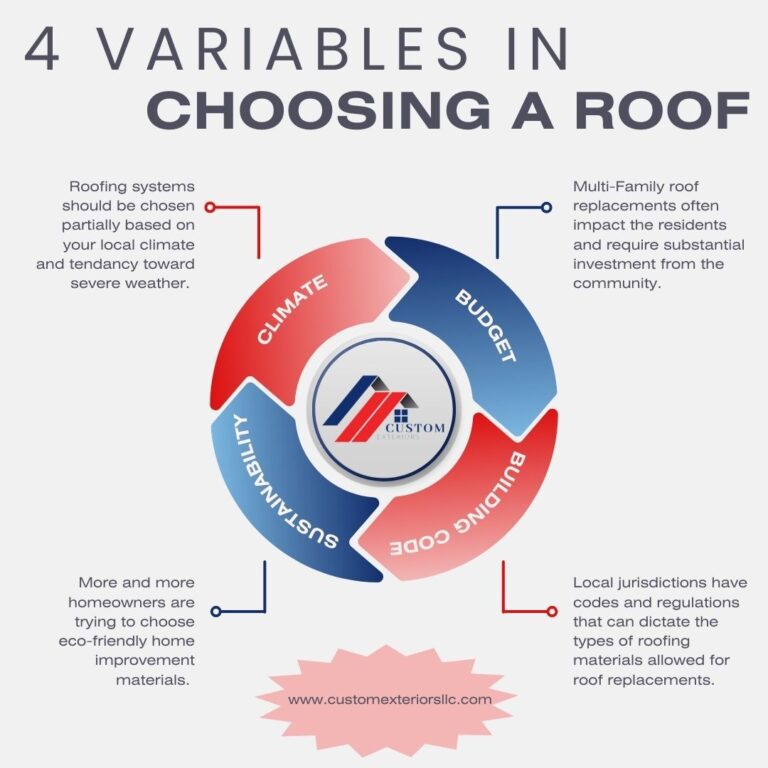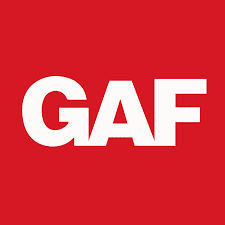Roof Types of multi-family buildings
The photo above was recently taken by one of our roofing inspectors during an HOA-managed community’s roof inspection. Do you notice anything unusual about it besides the stunning beauty of our Colorado mountains? In addition to being nestled in one of the most beautiful areas in the state, this complex also boasts a modern design with a flat roof. While most people associate flat roofing with a commercial building, they are often found on single-family and multi-family properties.
With our area’s rising costs, multi-family properties are becoming increasingly prominent. So, if you live in a managed community, learning about the common systems used on the exterior of your home can come in handy. This knowledge can help you make informed decisions when your multi-family roof replacement comes around.
Your roof is an intricate system that protects your property from everything the Colorado weather throws at it. Let’s look at some of the systems that can be used to protect your community.
Key Considerations When Replacing a Multi-Family Roof
Replacing the roof on a multi-family property can be an involved and complex process. Many factors differentiate a roofing project on a single-family home from one on an HOA-managed community for the roofing contractor and the residents. Several factors need to be considered when planning roofing for a multi-family property. We think the most important are:
Durability:
Durability is important because multi-family buildings experience higher wear due to the larger surface area of the roof. Additionally, the design of multi-family homeowners insurance coverage often means multi-family roof replacements will require significant financial investment from the community. This makes choosing a durable and long-lasting roof all the more important. The roof must be strong enough to handle weather conditions like heavy rain, snow, and strong winds without deteriorating quickly. While we all know there is no such thing as a hail-proof shingle, investing in a shingle that is impact-resistant may be a wise investment in the long run, preventing premature roof replacements.
Energy Efficiency:
Energy efficiency is another significant consideration. A well-chosen roof can help regulate indoor temperatures, lowering energy bills for property owners and tenants. Selecting materials that reflect sunlight or provide good insulation can make a noticeable difference in energy consumption, which is why we often see managed communities invest in metal roof replacements despite the increase in cost. A metal roof can be underlaid with additional insulation, significantly increasing energy efficiency. It’s reflective surface also helps reflect sunlight rather than absorbing it, particularly in lighter shades.
Maintenance Needs:
The community should also consider maintenance needs before replacing their roofs. Different roofing types require different levels of care, so it’s important to understand how often maintenance is needed and what it involves. For example, some roofs may need regular maintenance to prevent roof leaks, while others require less frequent attention.
Curb Appeal:
Lastly, the roof’s appearance affects the overall look of the property. While functionality is important, the roof should also complement the building’s design, as this can impact the property’s value and appeal to potential tenants. Balancing these factors ensures that the roof not only performs well but also contributes positively to the building as a whole. Choosing your roof’s color, material, and style will impact the appearance of your home.
According to Thumbtack, 58% of potential buyers say that a poorly maintained exterior has one of the most significant impacts on the home's exterior.
Common Types of Roofing for multi-family buildings
There are several common roofing options for multi-family buildings, each offering unique benefits. Understanding these choices helps property owners make informed decisions that best suit their needs. Let’s explore the roofing systems we see frequently on multi-family buildings.
Asphalt Shingles:

Asphalt Shingle roof systems are a popular choice for multi-family properties, especially for buildings with pitched roofs. They are known for their affordability and availability in various colors and styles. Asphalt shingles are relatively easy to install and provide solid protection against the elements. However, they may require regular maintenance to prevent issues like curling or cracking, especially in extreme weather conditions. Additionally, while Class 4 asphalt shingles are available, they are still more susceptible to damage than other roofing systems.
Unfortunately, they have a relatively short lifespan of 15-40 years. In Colorado, it is imperative to consider their durability against hail or wind storms. Asphalt shingles do not perform as well as some other systems in the long term. Because the property’s exterior is typically the association’s responsibility, longevity should be a consideration when choosing roofing materials.
Flat Roofs:
Flat Roofs, commonly found on multi-family buildings, are a cost-effective choice, providing space for equipment like HVAC units or solar panels. They are often used in buildings with modern or minimalistic architecture. These roofs are typically made of materials that resist leaks and UV rays. However, it’s important to remember that they require consistent maintenance to ensure proper drainage and prevent water pooling, which can lead to leaks over time. By staying on top of maintenance, you can proactively protect your investment.
There are many types of flat roofs for multi-family roof replacement. The most common include Built-Up Roofing, Modified Bitumen roofing (ModBit), EPDM Roofing, PVC Roofing, and TPO Roofing. Each has its advantages and disadvantages. Roof coatings can be added to aging flat roofs, extending their lifespan up to 15 additional years. This option alone helps make this a great choice for a multi-family roofing system.
Partnering with a qualified, local commercial roofer is essential when replacing a multi-family flat roof. They will assist you in choosing your replacement roof based on factors such as durability, cost, energy efficiency, and the climate and weather conditions in your area.

Metal Roofs:
Metal Roofs are another option, valued for their durability and long lifespan. Metal roofing is highly resistant to fire, strong winds, and other weather-related issues, making it a reliable choice for multi-family buildings in harsh climates. Metal roofs are also energy-efficient, reflecting sunlight and reducing cooling costs. While they may have a higher initial cost, their durability can result in lower long-term maintenance expenses.
Metal roofs are not just durable; they can also be quite beautiful. With an average lifespan of 50-70 years, they are a long-lasting and attractive choice for multi-family roof replacements. Available in various materials and colors, including aluminum, steel, copper, and zinc, they offer a high level of customization, enhancing the curb appeal of your property.
Metal roofs are often more expensive than other options, but they have a long lifespan, surpassing 70 years with proper care. Another factor to consider is your location’s probability of severe weather. Metal roofs offer excellent protection against the elements. Because of this, a metal roof can be a good choice in Colorado!

Synthetic Roofing:
Synthetic Roofing materials are gaining popularity due to their versatility and lightweight nature. These materials mimic the appearance of more expensive roofing types like slate or wood but at a lower cost and with less maintenance. Synthetic roofing is durable and resistant to common issues like mold, algae, and impact damage. This type of roofing is an excellent choice for property owners looking for an attractive and practical roofing solution.
Synthetic roofing is often less expensive and more fire-resistant than its natural counterparts. It also offers improved durability and performance in severe weather. However, some homeowners may prefer the look of raw materials. Some historical multi-family properties may have architectural guidelines that do not allow synthetic roofing.
Choosing the right roof for your multi-family property
So, how do you choose a roof that is beautiful, functional, and a durable addition to your property? Let’s look at a few things that could impact your selection.

First, the local climate plays a significant role in determining which roofing material will perform best. For example, areas with heavy snowfall may benefit from pitched roofs with asphalt shingles or metal that can handle the weight and encourage snow to slide off. In contrast, regions with mild weather may find flat or low-slope roofs more suitable. Many areas in Northern Colorado are prone to damaging hail, which makes a Class 4 shingle a wise choice.
Budget is another important factor. While some roofing materials may have a higher upfront cost, they could offer lower maintenance needs or a longer lifespan, ultimately saving money over time. It’s important to balance the initial investment with the long-term benefits to find the most cost-effective solution for your property.
Different areas have specific requirements for roofing materials, especially fire resistance, wind resistance, and load-bearing capabilities. In the last few years, the City of Fort Collins began requiring Class 4 shingles for every roof replacement due to the frequency of damaging storms. Ensuring that the chosen roofing system complies with local regulations is essential to avoid potential legal issues and ensure the safety of the building’s occupants.
Lastly, sustainability is becoming increasingly important for property owners. Eco-friendly roofing options, such as cool roofs or synthetic materials made from recycled products, can reduce environmental impact while providing long-term energy savings. Choosing a roofing system that meets both practical needs and sustainability goals can enhance the property’s value and appeal to environmentally-conscious tenants.
Making Informed Roofing Choices for Your Multi-family property
Selecting the right roofing system for a multi-family building is a significant decision that impacts the property’s durability, energy efficiency, maintenance needs, and overall value. By understanding the key considerations—such as the durability required, the importance of energy efficiency, and the varying maintenance needs of different roofing types—property managers and owners can make informed choices that meet both practical and financial goals.
Ultimately, the goal is to choose a roofing solution that not only protects the building but also enhances its value, satisfies tenants, and aligns with long-term objectives. Whether it’s ensuring compliance with local regulations or considering sustainability for future benefits, every element plays a role in making the right decision. Consulting with a professional roofing contractor can provide the expertise needed to navigate these choices and ensure that the roofing system selected is the best fit for the property.
By carefully considering these aspects, you can secure a roofing system that meets the demands of your multi-family property, offering reliability, cost-effectiveness, and peace of mind for years to come.
Contact Us Today
We Service and Support the Following Brands









Contact
Custom Exteriors, LLC
2881 S. 31st Ave, Greeley, CO 80631
109 E. 17th St. Ste 5822, Cheyenne, WY 82001
102 S. Tejon St. Ste 1100, Colorado Springs, CO 80903
404 Broadway, Eagle CO 81631
Phone: 970-460-8714
Toll Free: 800-580-0131
Quick Links
© 2022 Custom Exteriors, LLC


